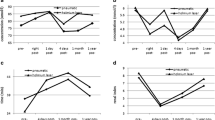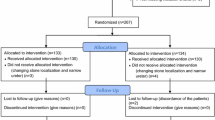Abstract
Purpose
We prospectively analyzed and compared the effectiveness and complications of pneumatic lithotripter with a holmium:yttrium–aluminum–garnet (Ho:YAG) laser for the ureterorenoscopic management of impacted ureteral stones.
Materials and methods
From January 2006 to January 2008, we performed retrograde endoscopic treatment in 288 patients with ureteral stones in our clinic. The patients with impacted stones were randomized into two groups according to the lithotripter used to fragment the stone: pneumatic (n = 40) and laser (n = 40). The preoperative, operative, and post-operative follow-up findings were analyzed and compared.
Results
The average stone size was similar in both groups (118.8 ± 58.3 mm2 vs. 110.7 ± 54.4 mm2). The calculi were located in the distal ureter in most of the patients in both groups (65% in pneumatic group and 52.5% in laser group). The operation time was significantly diminished in the laser group (P = 0.001). The stone-free rates after a single ureteroscopic procedure were 80 and 97.5% in the pneumatic and laser groups, respectively (P = 0.03). Auxiliary treatments were needed in seven patients in the pneumatic group, while only one patient in the laser group (P = 0.05) needed this treatment. After the additional procedures, a 100% success rate was achieved in both groups. The rate of double J stent insertion was significantly higher in the pneumatic group (P = 0.01). In the pneumatic group, four cases of stone up-migration and one case of post-operative stricture were seen, whereas only one case of stone up-migration was noted in the laser group.
Conclusion
Our comparative study has shown that the use of Ho:YAG as an intracorporeal lithotripter during ureteroscopic management of impacted ureteral stones is highly efficient with high success rates, regardless of the stone location.
Similar content being viewed by others
References
Deliveliotis C, Chrisofos M, Albanis S et al (2003) Management and follow up impacted utereral stones. Urol Int 70:269–272
Morgentaler A, Bridge SS, Dretler SP (1990) Management of the impacted ureteral calculus. J Urol 143:263–266
Dretler SP, Keating MA, Riley J (1986) An algorithm for the management of ureteral calculi. J Urol 136:1190–1193
Lingeman JE, Shirrell WL, Newman DM et al (1987) Management of upper ureteral calculi with extracorporeal shock wave lithotripsy. J Urol 138:720–723
Mueller SC, Wilbert D, Thueroff JW et al (1986) Extracorporeal shock wave lithotripsy of ureteral stones: clinical experience and experimental findings. J Urol 135:831–834
Chaussy CG, Fuchs GJ (1989) Current state and future developments of noninvasive treatment of human urinary stones with extracorporeal shock wave lithotripsy. J Urol 141:782–789
Mugiya S, Nagata M, Un-No T et al (2000) Endoscopic management of impacted ureteral stones using a small caliber ureteroscope and a laser lithotriptor. J Urol 164:329–331
Khairy-Salem H, El Ghoneimy M, El Atrebi M (2011) Semirigid ureteroscopy in management of large proximal ureteral calculi: is there still a role in developing countries? Urology http://hinarigw.who.int/whalecomwww.sciencedirect.com/whalecom0/science?_ob=MImg&_imagekey=B6VJW-521P96T-1-1&_cdi=6105&_user=2778664&_pii=S0090429510019618&_origin=search&_zone=rslt_list_item&_coverDate=01%2F26%2F2011&_sk=999999999&wchp=dGLzVzzzSkzk&md5=98ac193f052aaa576f63703ad5091693&ie=/sdarticle.pdf
Elganainy E, Hameed DA, Elgammal M, Abd-Elsayed AA, Shalaby M (2009) Experience with impacted upper ureteral stones; should we abandon using semirigid ureteroscopes and pneumatic lithoclast? Int Arch Med 2(1):13–17
Manohar T, Ganpule A, Desai M (2008) Comparative evaluation of Swiss LithoClast 2 and holmium:YAG laser lithotripsy for impacted upper-ureteral stones. J Endourol 22:443–446
Sun X, Xia S, Lu J et al (2008) Treatment of large impacted proximal ureteral stones: randomized comparison of percutaneous antegrade ureterolithotripsy versus retrograde ureterolithotripsy. J Endourol 22:913–917
Hofbauer J, Hobarth K, Marberger M (1992) LithoClast: New and inexpensive mode of intracorporeal lithotripsy. J Endourol 6:429–432
Turk C, Knoll T, Petrik A et al (2010) Guidelines on urolithiasis. Eur Assoc Urol 1–106
Huffman JL, Bagley DH, Lyon ES (1985) Abnormal ureter and intrarenal collecting system. In: Bagley DH, Huffman JL, Lyon ES (eds) Urologic endoscopy: a manual and atlas, Chapter 6. Little, Brown and Co., Boston, pp 59–73
Dretler SP, Young RH (1993) Stone granuloma: a cause of ureteral stricture. J Urol 150:1800–1802
Motola JA, Smith AD (1992) Complications of ureteroscopy: prevention and treatment. AUA update series, volume 11, lesson 21
Cotran RS, Kumar V, Robbins SL (1989) Robbins pathologic basis of disease, chapter 3, 4th edn. W.B.Saunders Co, Philadelphia, pp 39–86
Mitchinson MJ, Bird DR (1971) Urinary leakage and retroperitoneal fibrosis. J Urol 105:56–58
Roberts WW, Cadeddu JA, Micali S et al (1998) Ureteral stricture formation after removal of impacted calculi. J Urol 159:723–726
Brito Artur H, Mitre Anuar I, Miguel Srougi (2006) Ureteroscopic pneumatic lithotripsy of impacted ureteral calculi. Int Braz J Urol 32:295–299
Eisner BH, Dretler SP (2009) Use of the Stone Cone for prevention of calculus retropulsion during holmium:YAG laser lithotripsy: case series and review of the literature. Urol Int 82:356–360
Dretler SP (2001) The stone cone: a new generation of basketry. J Urol 165:1593–1596
Desai MR, Patel SB, Desai MM et al (2002) The Dretler stone cone: a device to prevent ureteral stone migration-the initial clinical experience. J Urol 167:1985–1988
Seitz C, Tanovic E, Kikic Z et al (2007) Impact of stone size, location, composition, impaction, and hydronephrosis on the efficacy of holmium: YAG laser ureterolithotripsy. Eur Urol 52:1751–1759
Dushinski JW, Lingeman JE (1997) Urologic applications of the Holmium laser. Tech Urol 3:60–64
Teichman JM (2002) Laser lithotripsy. Curr Opin Urol 12:305–309
Author information
Authors and Affiliations
Corresponding author
Rights and permissions
About this article
Cite this article
Binbay, M., Tepeler, A., Singh, A. et al. Evaluation of pneumatic versus holmium:YAG laser lithotripsy for impacted ureteral stones. Int Urol Nephrol 43, 989–995 (2011). https://doi.org/10.1007/s11255-011-9951-8
Received:
Accepted:
Published:
Issue Date:
DOI: https://doi.org/10.1007/s11255-011-9951-8




